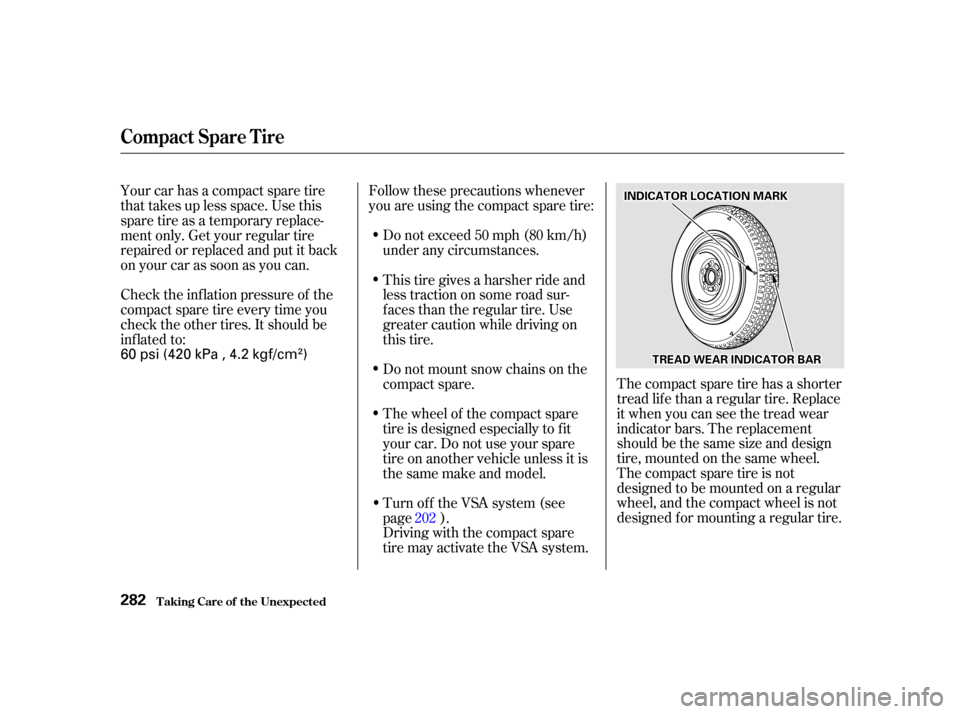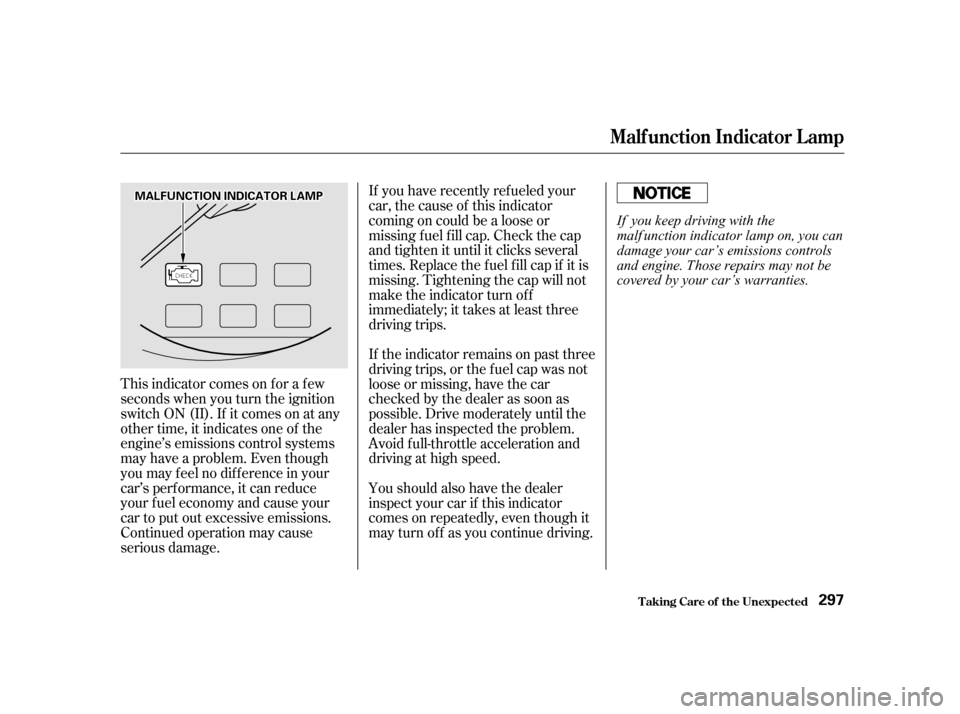ECO mode Acura RL 2002 3.5 Owner's Guide
[x] Cancel search | Manufacturer: ACURA, Model Year: 2002, Model line: RL, Model: Acura RL 2002Pages: 343, PDF Size: 4.66 MB
Page 186 of 343

A cold engine uses more f uel than a
warm engine. It is not necessary to
‘‘warm-up’’ a cold engine by letting it
idle f or a long time. You can drive
away in about a minute, no matter
how cold it is outside. The engine
will warm up f aster, and you get
better f uel economy. To cut down on
the number of ‘‘cold starts,’’ try to
combine several short trips into one.
You can improve f uel economy by
driving moderately. Rapid acceler-
ation, abrupt cornering, and hard
braking use more f uel.
Always drive in the highest gear that
allows the engine to run and acceler-
ate smoothly.
An important part of that mainte-
nance is the (see page ). For
example, an underinf lated tire
causes more ‘‘rolling resistance,’’
which uses f uel. It also wears out
f aster, so check the tire pressure at
least monthly. The air conditioning puts an extra
load on the engine which makes it
usemorefuel.Turnoff theA/Cor
set the climate control to a higher
temperature to cut down on air
conditioning use. Use the flow-
through ventilation when the outside
air temperature is moderate.
The condition of your car and your
driving habits are the two most
important things that affect the fuel
mileage you get.
Always maintain your car according
to the maintenance schedule. This
will keep it in top operating condition.
In winter, the build-up of snow on
your car’s underside adds weight and
rolling resistance. Frequent cleaning
helps your f uel mileage and reduces
thechanceof corrosion.
Depending on traf f ic conditions, try
to maintain a constant speed. Every
time you slow down and speed up,
your car uses extra f uel. Use the
cruise control, when appropriate, to
increase f uel economy.
225 Driving Habits
Owner Maintenance
Checks Car Condition
Fuel Economy
Bef ore Driving183
01/09/28 19:55:34 31SZ3660_186
Page 285 of 343

Follow these precautions whenever
you are using the compact spare tire:Thecompactsparetirehasashorter
tread lif e than a regular tire. Replace
it when you can see the tread wear
indicator bars. The replacement
shouldbethesamesizeanddesign
tire, mounted on the same wheel.
Thecompactsparetireisnot
designed to be mounted on a regular
wheel, and the compact wheel is not
designed f or mounting a regular tire.
Check the inf lation pressure of the
compact spare tire every time you
check the other tires. It should be
inf lated to:
Do not exceed 50 mph (80 km/h)
under any circumstances.
This tire gives a harsher ride and
less traction on some road sur-
f aces than the regular tire. Use
greater caution while driving on
this tire.
Do not mount snow chains on the
compact spare.
Your car has a compact spare tire
that takes up less space. Use this
sparetireasatemporaryreplace-
ment only. Get your regular tire
repaired or replaced and put it back
on your car as soon as you can.
The wheel of the compact spare
tire is designed especially to f it
your car. Do not use your spare
tire on another vehicle unless it is
thesamemakeandmodel.
Turn of f the VSA system (see
page ).
Driving with the compact spare
tiremayactivatetheVSAsystem.202
Compact Spare Tire
T aking Care of t he Unexpect ed282
I IN
ND DI
ICCA A T
TO
OR R L
LOOC CAA T
TI
IOON N M
MA
AR
RKK
T
T R
RE EA
A D
D W
WE EA
A R
R I
INND DI
ICCA A T
TO
OR R B
BAA R
R
60 psi (420 kPa , 4.2 kgf/cm)
01/09/28 20:11:25 31SZ3660_285
Page 300 of 343

This indicator comes on f or a f ew
seconds when you turn the ignition
switch ON (II). If it comes on at any
other time, it indicates one of the
engine’s emissions control systems
may have a problem. Even though
you may f eel no dif f erence in your
car’s perf ormance, it can reduce
your f uel economy and cause your
car to put out excessive emissions.
Continued operation may cause
serious damage.If the indicator remains on past three
driving trips, or the f uel cap was not
loose or missing, have the car
checked by the dealer as soon as
possible. Drive moderately until the
dealer has inspected the problem.
Avoid full-throttle acceleration and
driving at high speed.
Youshouldalsohavethedealer
inspect your car if this indicator
comes on repeatedly, even though it
may turn of f as you continue driving. If you have recently ref ueled your
car, the cause of this indicator
coming on could be a loose or
missing f uel f ill cap. Check the cap
and tighten it until it clicks several
times. Replace the fuel fill cap if it is
missing. Tightening the cap will not
make the indicator turn of f
immediately; it takes at least three
driving trips.
Malf unction Indicator L amp
T aking Care of t he Unexpect ed297
M M
A
AL
LFFUUN NCCTTI
IOON N I
INND DI
ICCA A T
TO
OR R L
LAA M
M P
P
If you keep driving with the
malf unction indicator lamp on, you can
damage your car’s emissions controls
and engine. Those repairs may not be
covered by your car’s warranties.
01/09/28 20:13:47 31SZ3660_300